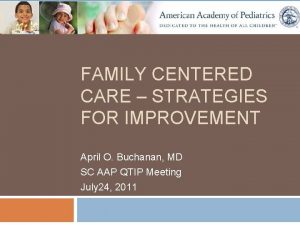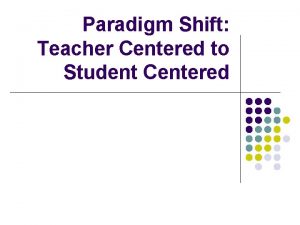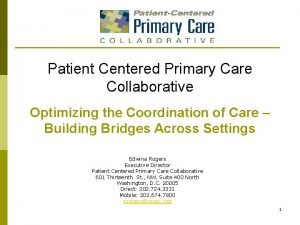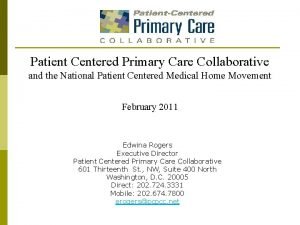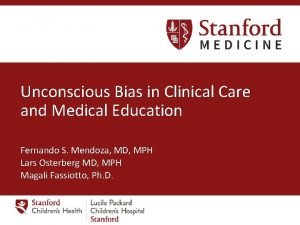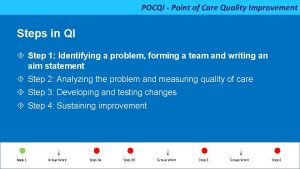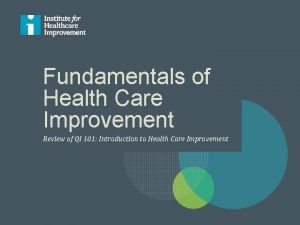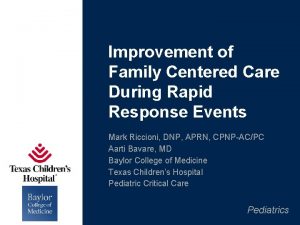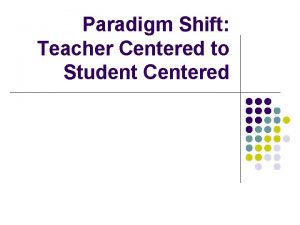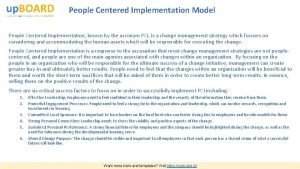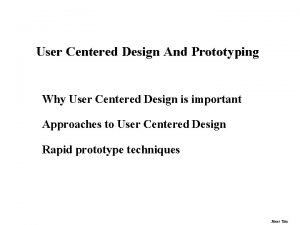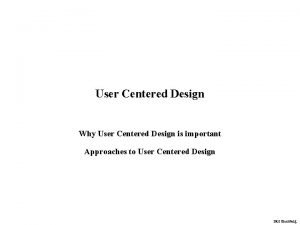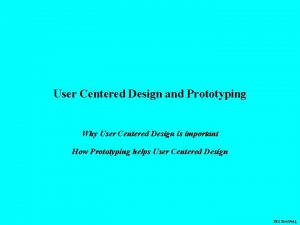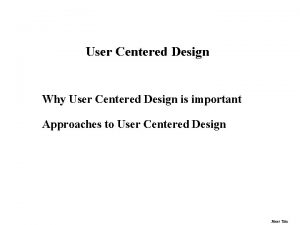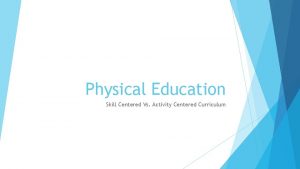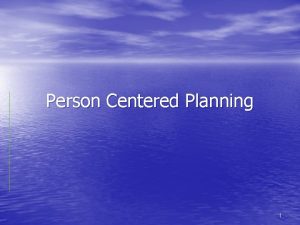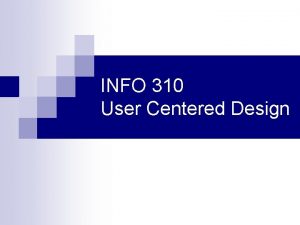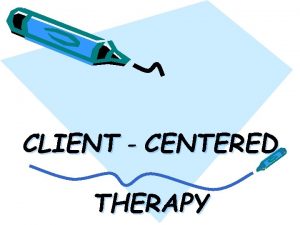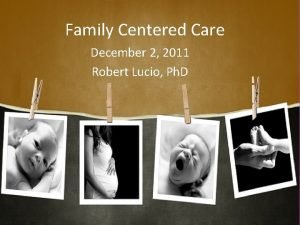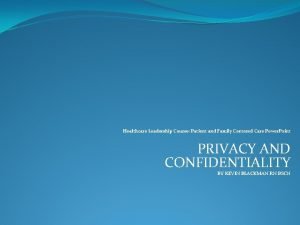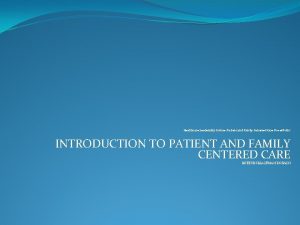FAMILY CENTERED CARE STRATEGIES FOR IMPROVEMENT April O






























- Slides: 30

FAMILY CENTERED CARE – STRATEGIES FOR IMPROVEMENT April O. Buchanan, MD SC AAP QTIP Meeting July 24, 2011

Objectives Integrate CAHPS measures and family centered care Understand methods for improving access and timeliness Review important aspects of family/physician communication Develop strategies for family involvement in your practice

Benefits of Family Centered Care Improves outcomes of care for children Efficiently and effectively uses health care resources Improves access to care Improves quality/safety of care Assists in the realization of the medical home Promotes cultural effectiveness Provides a stronger voice for children/family issues

CAHPS Access Getting Needed Care Getting Care Quickly Interpersonal Care How Well Doctors Communicate Doctors listen carefully Doctors explain things clearly Doctors respected your comments Doctors spent enough time Courteous and Helpful Office Staff

Getting Needed Care and Getting Care Quickly Phone Calls – how are they handled? Access to Email Internet Access Standards for Customer Service Training for Physicians and Staff Open Access Scheduling Streamlined Patient Flow

How Patients/Families Want to Use Email Communication To request and provide information or advice related to non-urgent concerns To request administrative help (e. g. , with forms) and schedule appointments To request referrals To receive reminders To clarify billing issues To communicate results of lab and diagnostic tests The CAHPS Improvement Guide: Practical Strategies for Improving the Patient Care Experience

How Patients/Families Want to Use Email Communication To request and refill prescriptions To transmit patient-monitored clinical measures, such as blood pressure, glucose levels, or temperature To provide patient education and other materials, including links to appropriate Web sites The CAHPS Improvement Guide: Practical Strategies for Improving the Patient Care Experience

Benefits of Email Communication Convenient, fast, asynchronous (i. e. , both people do not have to be available at the same time), unintrusive (i. e. , it does not interrupt the recipient on either end) Easy to track and manage, unlike telephone messages Has the potential to improve patient-centered care and increase self-management, while increasing timeliness and efficiency Increase in patient involvement in their own Mandl, Kohane et al. 1998 care The CAHPS Improvement Guide: Practical Strategies for Improving the Patient Care Experience

Guidelines For Email Communication Not for urgent issues Avoid disclosing any highly sensitive and confidential information Clinician should respond to all emails from patients with whom they have established relationships, ideally by the next business day Patients should include identifying information (e. g. , a name and patient identification number) in the body of the message. Both clinicians and patients should send automatic replies to indicate that a message was received. Patients should be asked for their informed consent prior to using email communications Clinicians and staff should develop and implement specific steps to decrease the risk of unauthorized (Kane and Sands 1998; Sittig, King et al. 2001; e. Risk Working Group on Healthcare 2002) access to patients’ emails.

Secure Messaging Relay. Health. com My. Doc. Online. com Healthy. Email. org Well. Med. com Patients submit forms and templates, rather than free-flow text Can improve efficiency over free text emails The CAHPS Improvement Guide: Practical Strategies for Improving the Patient Care Experience

Internet Site Expand your own Web site to include health information and relevant tools as well as links to related information Consider terminals at nearby library or school Demo in the clinic waiting area

Access to Care Walk-ins Same day sick appointments Seeing all patients every day Assigned late doc each day Anticipating visits and leaving slots open Evening and weekend hours

Streamlined Patient Flow diagram Do a walk through

How Well Doctors Communicate Training Physicians to Communicate Group Visits Tools to Help Patients What do I want to tell my doctor today? What do I want to ask my doctor today? Shared Decision Making Evidence-Based Information Standardized patient information and instruction sheets Planned Visits

Communication is a two-way street Record Sharing Patient Question Lists (a. k. a. Doc Talk Cards) Coached Care The CAHPS Improvement Guide: Practical Strategies for Improving the Patient Care Experience

Family Engagement in Pediatrics Asking patients and families what matters most to them is critical to engaging them in care

AHRQ…. “Engaging Patients and Families in the Medical Home” The most common complaint about the current patient-centered medical home demonstration projects is “that there is not enough emphasis on the ‘patient-centered’ nature of the medical home. ” Practices need guidance on how to identify, recruit and meaningfully involve patients and families in practice improvement.

NCQA PCMH 2011 Standards PCMH 4: The Practice acts to improve patients’/ families’ ability to manage their health by providing a self-care plan, tools, educational resources and on-going support PCMH 6 Element B Surveys family experiences in access, communication, coordination and whole-person care Uses Patient-Centered Medical Home version of CAHPS Obtains feedback from families through qualitative means

Family Involvement Direct interviews Focus Groups Suggestion boxes Patient and Family Advisory Councils Adolescent Advisory Group Resource Development and Identification

New Patients Assignment of a person to a caregiver Orientation to the practice and its services First visit, initial assessment, and care planning Delivery of health care services: acute, chronic, and preventive The CAHPS Improvement Guide: Practical Strategies for Improving the Patient Care Experience

Shared Decision-Making Consumer participation can increase patient satisfaction and lead to better health outcomes (Greenfield, Kaplan et al. 1985; Greenfield, Kaplan et al. 1988; Kaplan, Greenfield et al. 1989) Patients who are empowered to make decisions about their health that better reflect their personal preferences often experience more favorable health outcomes such as decreased anxiety, quicker recovery and increased compliance with treatment regimens (Guadagnoli and Ward 1998) Greater consumer involvement in decision making leads to lower demand for health care resources (Devine and Cook 1983) The CAHPS Improvement Guide: Practical Strategies for Improving the Patient Care Experience

Support Groups and Self Care Patients often express dissatisfaction because they are not getting everything they need from the clinicians – but in many cases, what they need is not something that the clinicians can provide. While many physicians believe that they can (or should be able to) satisfy all of their patients’ needs, including the need for self-care, this presumption is not realistic or helpful for them or their patients – particularly for those with chronic conditions. Clinicians need to accept that this is a role better filled by others and help their patients connect The CAHPS Improvement Guide: Practical Strategies for Improving the Patient Care Experience

Collaboration Among Physicians and Parents Create mutual trust between physicians and parents Learn from each other Adopt new perspectives Link to new resources The Real benefits of patient and family centered care is building mutually beneficial relationships!

Considerations Assure that family representatives/involvement are matched to the task What kind of family input do you need? Who has that expertise? Does that parent represent their own experience or that of a larger family advocacy organization? What additional parenting experiences in addition to those already at the table do we need? How do we be strategic in getting the appropriate family input?

Potential PDSA Cycles Pilot of e-mail communication Survey families pre and post Improved internet site Survey families pre and post Utilize families in the improvement process Develop a Family Advisory Group Survey physicians, nurses, staff, and families pre and post Track practice improvements Utilize a Suggestion Box Develop new PDSA cycles from suggestions

Resources The CAHPS Improvement Guide: Practical Strategies for Improving the Patient Care Experience http: //www. improvingchroniccare. org/download s/advanced_topics_cahps_improvement_guid e. pdf American Academy of Pediatrics website www. ncqa. org Engaging Patients and Families in the Medical Home. www. pcmh. ahrq. gov

References Devine, E. C. and T. D. Cook (1983). “A meta-analytic analysis of effects of psychoeducational interventions on length of postsurgical hospital stay. ” Nurs Res 32(5): 267 -74. e. Risk Working Group on Healthcare (2002). “Guidelines for Online Communications, ” November 2002. (The e. Risk Working Group for Healthcare is a consortium that includes the AMA, other leading national medical societies, and liability carriers. ) These guidelines are available at www. medem. com/erisk. Greenfield, S. Kaplan, et al. (1985). “Expanding patient involvement in care. Effects on patient outcomes. ” Ann Intern Med 102(4): 520 -8. Greenfield, S. H. Kaplan, et al. (1988). “Patients’ participation in medical care: effects on blood sugar control and quality of life in diabetes. ” J Gen Intern Med 3(5): 448 -57. Guadagnoli, E. and P. Ward (1998). “Patient participation in decision-making. ” Soc Sci Med 47(3): 329 -39.

References Kane, B. and D. Z. Sands (1998). “Guidelines for the Clinical Use of Electronic Mail with Patients. The AMIA Internet Working Group, Task Force on Guidelines for the Use of Clinic-Patient Electronic Mail. ” Journal of the American Medical Informatics Association 5(1): 104 -11. These guidelines are available at the Web site of the Electronic Patient Centered Communication Resource Center: www. e-pcc. org. Kaplan, S. H. , S. Greenfield, et al. (1989). “Assessing the effects of physician-patient interactions on the outcomes of chronic disease. ” Med Care 27(3 Suppl): S 110 -27. Mandl KD, Kohane IS, Brandt AM. Electronic Patient-Physician Communication: Problems and Promise. Annals of Internal Medicine, 15 September 1998. 129: 495 -500. Sittig, D. F. , S. King, et al. (2001). “A survey of patient-provider e -mail communication: what do patients think? ” Int J Med Inf 61(1): 71 -80.

Special Thanks Francis Rushton for use of some of his slides on Family Centered Care

Contact Info April Buchanan, MD abuchanan@ghs. org
 Strategies of family centered care
Strategies of family centered care Family centered care definition
Family centered care definition Stock image
Stock image Four improvement strategies in tqm
Four improvement strategies in tqm Attendance improvement strategies
Attendance improvement strategies Qsen phases
Qsen phases Patient centered primary care collaborative
Patient centered primary care collaborative Patient centered care collaborative
Patient centered care collaborative Patient centered care
Patient centered care Levels of care primary secondary tertiary quaternary
Levels of care primary secondary tertiary quaternary Pocqi ppt
Pocqi ppt Qi 101: introduction to health care improvement
Qi 101: introduction to health care improvement Family business growth strategies
Family business growth strategies Formuö
Formuö Novell typiska drag
Novell typiska drag Tack för att ni lyssnade bild
Tack för att ni lyssnade bild Ekologiskt fotavtryck
Ekologiskt fotavtryck Shingelfrisyren
Shingelfrisyren En lathund för arbete med kontinuitetshantering
En lathund för arbete med kontinuitetshantering Särskild löneskatt för pensionskostnader
Särskild löneskatt för pensionskostnader Tidbok
Tidbok A gastrica
A gastrica Vad är densitet
Vad är densitet Datorkunskap för nybörjare
Datorkunskap för nybörjare Boverket ka
Boverket ka Debattinlägg mall
Debattinlägg mall Autokratiskt ledarskap
Autokratiskt ledarskap Nyckelkompetenser för livslångt lärande
Nyckelkompetenser för livslångt lärande Påbyggnader för flakfordon
Påbyggnader för flakfordon Lufttryck formel
Lufttryck formel Offentlig förvaltning
Offentlig förvaltning
